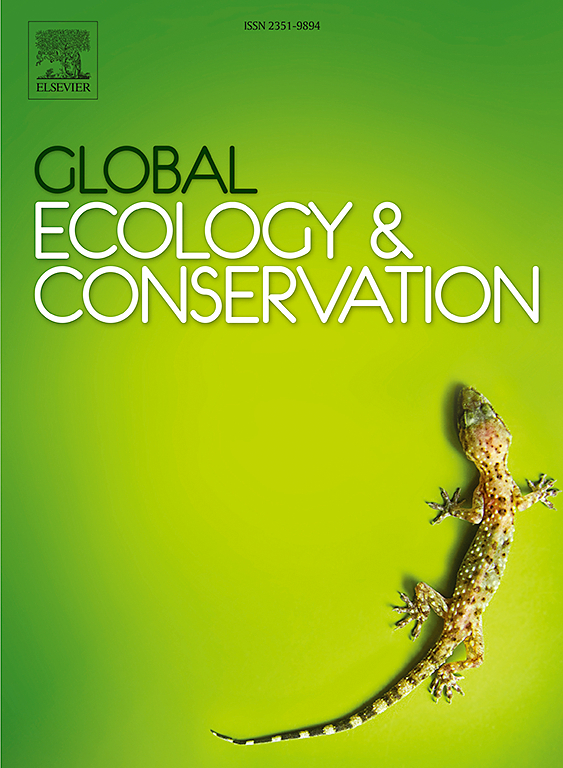雨林转变为单一人工林改变了甲螨的密度、物种丰富度和群落组成,并选择了孤雌生殖的优势种
IF 3.5
2区 环境科学与生态学
Q1 BIODIVERSITY CONSERVATION
引用次数: 0
摘要
雨林向油棕和橡胶种植园的转变对热带生物多样性构成了重大威胁。这在许多地上和地下分类群中都有很好的记载;然而,这在多大程度上适用于甲螨的研究很少。甲螨(Oribatida, Acari)是一种普遍存在的丰富多样的土壤无脊椎动物,对土地利用变化反应敏感。本文研究了印度尼西亚占比省热带低地雨林转变为油棕和橡胶种植园后,甲螨的密度、物种丰富度、群落组成和生活史策略的变化。占比省是印度尼西亚森林砍伐严重的地区。从四种不同土地利用系统的凋落物和土壤中取样甲螨:雨林、橡胶农林业(“丛林橡胶”)、橡胶和油棕单一种植种植园。凋落物层的甲螨对土地利用变化的响应比土壤中的甲螨更敏感,橡胶和油棕人工林的甲螨密度和物种丰富度显著低于雨林。热带雨林和杂耍橡胶的群落组成相似,与橡胶和油棕种植园的群落组成不同。在单作人工林中,甲螨生活史策略转向孤雌生殖,生殖板较大,而对性比、雌卵数和体型的影响较小。土壤pH和含水量是凋落物和土壤群落组成的主要驱动因素,而土壤微生物生物量仅与凋落物中甲螨群落组成相关。我们的研究结果强调了植物凋落物在面对土地利用变化时支持甲螨群落的关键作用。热带雨林和丛林橡胶相似的群落结构、生活史策略和环境特征表明,农林业是保护人工林系统土壤生物多样性的一种有前景的管理选择。本文章由计算机程序翻译,如有差异,请以英文原文为准。
Transformation of rainforest into monoculture plantations alters the density, species richness and community composition of oribatid mites and selects for a higher dominance of parthenogenetic species
The transformation of rainforests into oil palm and rubber plantations poses a major threat to tropical biodiversity. This has been well documented for a number of above- and belowground taxa; however, to what extent this applies to oribatid mites is little studied. Oribatid mites (Oribatida, Acari) are ubiquitous, abundant and diverse soil invertebrates, sensitively responding to land-use changes. Here, we examined alterations in density, species richness, community composition and life history strategy of oribatid mites following the transformation of tropical lowland rainforests into oil palm and rubber plantations in Jambi province, Sumatra, a region heavily affected by deforestation in Indonesia. Oribatid mites were sampled from litter and soil of four different land-use systems: rainforest, rubber agroforest (‘jungle rubber’), rubber and oil palm monoculture plantations. Oribatid mites in the litter layer more sensitively responded to changes in land use than those in soil, with density and species richness in rubber and oil palm plantations being significantly lower than those in rainforest. Community composition in rainforest and juggle rubber was similar, and distinct from that in rubber and oil palm plantations. In monoculture plantations, life history strategy of oribatid mites shifted towards parthenogenetic reproduction with larger genital plate, while sex ratio, egg number per female and body size were little affected. Soil pH and water content were identified as main drivers of community composition in both litter and soil, while soil microbial biomass correlated only with oribatid mite community composition in litter. Our results stress the critical role of plant litter in supporting oribatid mite communities in the face of land-use change. The similar community structure, life history strategies and environmental characteristics in rainforest and jungle rubber point to agroforestry as a promising management option to safeguard soil biodiversity in plantation systems.
求助全文
通过发布文献求助,成功后即可免费获取论文全文。
去求助
来源期刊

Global Ecology and Conservation
Agricultural and Biological Sciences-Ecology, Evolution, Behavior and Systematics
CiteScore
8.10
自引率
5.00%
发文量
346
审稿时长
83 days
期刊介绍:
Global Ecology and Conservation is a peer-reviewed, open-access journal covering all sub-disciplines of ecological and conservation science: from theory to practice, from molecules to ecosystems, from regional to global. The fields covered include: organismal, population, community, and ecosystem ecology; physiological, evolutionary, and behavioral ecology; and conservation science.
 求助内容:
求助内容: 应助结果提醒方式:
应助结果提醒方式:


